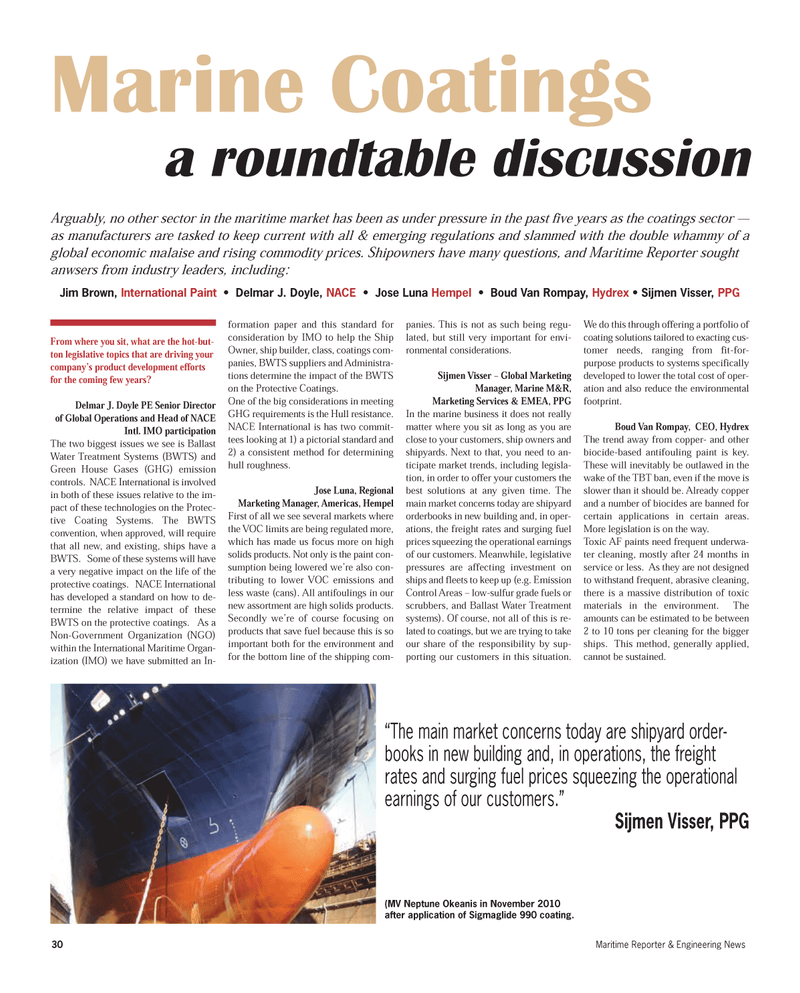
Page 30: of Maritime Reporter Magazine (July 2012)
Arctic Operations
Read this page in Pdf, Flash or Html5 edition of July 2012 Maritime Reporter Magazine
30Maritime Reporter & Engineering News From where you sit, what are the hot-but- ton legislative topics that are driving your company?s product development efforts for the coming few years? Delmar J. Doyle PE Senior Director of Global Operations and Head of NACE Intl. IMO participationThe two biggest issues we see is Ballast Water Treatment Systems (BWTS) and Green House Gases (GHG) emissioncontrols. NACE International is involved in both of these issues relative to the im- pact of these technologies on the Protec-tive Coating Systems. The BWTS convention, when approved, will require that all new, and existing, ships have a BWTS. Some of these systems will have a very negative impact on the life of the protective coatings. NACE International has developed a standard on how to de- termine the relative impact of these BWTS on the protective coatings. As a Non-Government Organization (NGO) within the International Maritime Organ- ization (IMO) we have submitted an In- formation paper and this standard forconsideration by IMO to help the ShipOwner, ship builder, class, coatings com- panies, BWTS suppliers and Administra- tions determine the impact of the BWTSon the Protective Coatings. One of the big considerations in meetingGHG requirements is the Hull resistance.NACE International is has two commit- tees looking at 1) a pictorial standard and2) a consistent method for determininghull roughness. Jose Luna, Regional Marketing Manager, Americas, Hempel First of all we see several markets where the VOC limits are being regulated more, which has made us focus more on highsolids products. Not only is the paint con-sumption being lowered we?re also con- tributing to lower VOC emissions and less waste (cans). All antifoulings in our new assortment are high solids products. Secondly we?re of course focusing on products that save fuel because this is so important both for the environment and for the bottom line of the shipping com-panies. This is not as such being regu- lated, but still very important for envi- ronmental considerations.Sijmen Visser ? Global Marketing Manager, Marine M&R, Marketing Services & EMEA, PPG In the marine business it does not really matter where you sit as long as you areclose to your customers, ship owners and shipyards. Next to that, you need to an- ticipate market trends, including legisla- tion, in order to offer your customers the best solutions at any given time. The main market concerns today are shipyard orderbooks in new building and, in oper- ations, the freight rates and surging fuel prices squeezing the operational earningsof our customers. Meanwhile, legislative pressures are affecting investment on ships and fleets to keep up (e.g. Emission Control Areas ? low-sulfur grade fuels or scrubbers, and Ballast Water Treatment systems). Of course, not all of this is re-lated to coatings, but we are trying to take our share of the responsibility by sup-porting our customers in this situation.We do this through offering a portfolio of coating solutions tailored to exacting cus- tomer needs, ranging from fit-for- purpose products to systems specifically developed to lower the total cost of oper- ation and also reduce the environmental footprint.Boud Van Rompay, CEO, Hydrex The trend away from copper- and other biocide-based antifouling paint is key. These will inevitably be outlawed in the wake of the TBT ban, even if the move is slower than it should be. Already copper and a number of biocides are banned forcertain applications in certain areas.More legislation is on the way. Toxic AF paints need frequent underwa- ter cleaning, mostly after 24 months inservice or less. As they are not designed to withstand frequent, abrasive cleaning, there is a massive distribution of toxic materials in the environment. The amounts can be estimated to be between2 to 10 tons per cleaning for the biggerships. This method, generally applied, cannot be sustained.Marine Coatingsa roundtable discussionArguably, no other sector in the maritime market has been as under pressure in the past five years as the coatings sector ? as manufacturers are tasked to keep current with all & emerging regulations and slammed with the double whammy of a global economic malaise and rising commodity prices. Shipowners have many questions, and Maritime Reporter sought anwsers from industry leaders, including: Jim Brown, International Paint Delmar J. Doyle, NACE Jose Luna Hempel Boud Van Rompay, Hydrex Sijmen Visser, PPG?The main market concerns today are shipyard order- books in new building and, in operations, the freight rates and surging fuel prices squeezing the operational earnings of our customers.?Sijmen Visser, PPG (MV Neptune Okeanis in November 2010 after application of Sigmaglide 990 coating.MR#7 (26-33):MR Template 7/9/2012 9:42 AM Page 30

 29
29

 31
31
